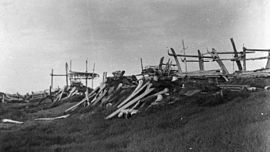- Tikiġaġmiut
-
The Tikiġaġmiut, an Inuit people, live two hundred miles north of the Arctic Circle, 330 miles (531 km) southwest of Barrow, Alaska, in an Inupiaq village of Point Hope, Alaska (in Inupiak language Tikiġaq).[1] The Tikigaq are the oldest continuously settled Native American site on the continent. They are native whale hunters with centuries of experience co-existing with the Chukchi Sea that surrounds their Point Hope Promontory on three sides. "Tikiġaq" means "index finger" in the Inupiaq language.
Contents
History
1500 years ago, when Tikiġaġmiut first settled the Point Hope area, they did not depend on whale hunting. Instead, early Tikiġaġmiut were notable for producing elaborate and beautiful art in an artstyle called Ipiutak, after the place where archaeologists first found the artwork. But the Tikagaq's past is a present-day mystery with no explanation for where the ideas for the art came from, nor how a large population was sustained during their earliest centuries without whale dependence.[2]
The Tikigaq relied on berries and roots for food, local willows for house frames, and moss or grass for lamp wicks and insulation.
Today, distribution and movement of game, especially the beluga, Bowhead whale, caribou, seal, walrus, fur-bearing animals, polar bear and grizzly bear, directly affect the lives of Tikigaq.[3]
Daily life
While ancillary health care is provided by the local volunteer fire department, the closest physician is in Kotzebue, Alaska, 180 miles (290 km) away.
About one of three Tikiġaġmiut homes lack running water or sewer connections.
Culture
Also known as Tikigaqmuit or Tikigaqmiut,[3] the Tikiġaġmiut people used to live close together for half the year in underground whale-bone, driftwood, and dirt houses that were connected by tunnels. Tikigaqmiut today live in modern, but sometimes out-dated houses. Their connections include the spirits of ancestors, the sun, the moon, and animal worship. Tikiġaġmiut sustain myths about their homeland once being a great whale killed by a shaman's harpoon. Their year involves storytelling, rituals, dances, shamanic seances, puppet shows, divinations, spirit guests, encounters with animal souls, and lunar rites, culminating in the spring with the annual whale hunt. [4]
Tikiġaġmiut people have complex kinship and alliance webs.
Education
Tikigaq School, part of the North Slope Borough School District,[5] is the second largest K-12 in Alaska, serving more than 250 children. Notable to the school's curriculum is a three-week whaling class where a small group of students learn specific whaling traditions and skills.[3]
Notes
- ^ "Point Hope, Alaska". tikigaq.com. http://www.tikigaq.com/point_hope.shtml. Retrieved 2007-09-30.
- ^ "Tikigaq: A Permanent Settlement for More than 1000 Years". akhistory. http://www.akhistory.org/index.cfm?FuseAction=viewbottomframe&PageID=69&OpenMenu=178&NavID=187. Retrieved 2007-09-30.
- ^ a b c "Tikigaq". tikigaq.com. http://www.tikigaq.com/inupiaq_people.shtml. Retrieved 2007-09-30.
- ^ Tom Lowenstein (January 2000). ""Ancient Land, Sacred Whale"". Barnes and Noble. http://search.barnesandnoble.com/booksearch/isbnInquiry.asp?z=y&EAN=9781860465758. Retrieved 2007-09-30.
- ^ "TIKIGAQ SCHOOL QUICK REPORT". schoolsk-12.com. http://www.schoolsk-12.com/Alaska/Point-Hope/TIKIGAQSCHOOL.html. Retrieved 2007-09-30.
Further reading
- Asatchaq, Jimmie Killigivuk and Tom Lowenstein. The Things That Were Said of Them: Shaman Stories and Oral Histories of the Tikiġaq People. Berkeley: University of California Press, 1992. ISBN 0520065697
External links
Categories:- Indigenous peoples of North America
- Inuit groups
- Inupiaq words and phrases
Wikimedia Foundation. 2010.


